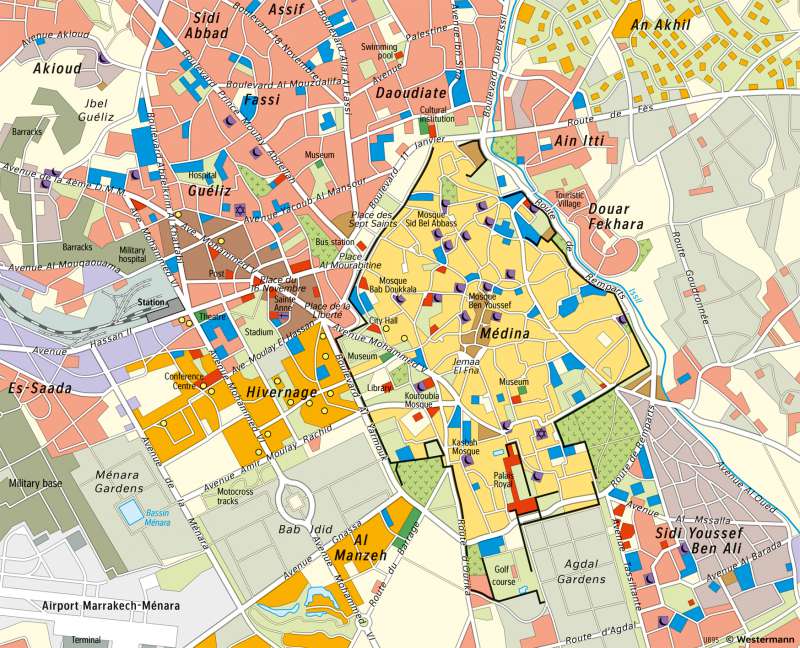Medina of Marrakech (Morocco) - UNESCO World heritage
World heritage and topographic orientation
978-3-14-100890-6 | Page 142 | Ill. 1

Overview
Bustling activity in winding alleys – this is how one imagines the old town (medina) of an oriental city. The souk (market) is still the centre of trade and commerce, and the other typical elements of a traditional, oriental city, such as the kasbah (castle), the dead-end streets, the mosques (houses of prayer), minarets (towers for prayer callers), the hamams (bathhouses) and the madrasas (schools) can all be found in Marrakech's medina. They are surrounded by the historic city wall, which also describes the boundaries of the UNESCO World heritage site. Outside the city walls are traditionally the cemeteries.
World heritage site
In 1985, the Medina of Marrakesh was declared a World heritage site. The following four of the ten categories were fulfilled:
(i) to represent a masterpiece of human creative genius: In Marrakesh, a large number of the properties would fall under the Masterpiece of architecture and art category, each of which would fulfil the category of “outstanding universal valueâ€;
(ii) to exhibit an important interchange of human values – over a span of time or within a cultural area of the world – on developments in architecture or technology, monumental arts, town-planning or landscape design: Marrakech became the capital of the Almoravids/Almohads and played a significant role in medieval urban development;
(iv) to be an outstanding example of a type of building, architectural or technological ensemble or landscape which illustrates a significant stage in human history: Marrakech is a perfect example of a great Islamic capital in the Western Mediterranean;
(v) to be an outstanding example of a traditional human settlement, land-use, or sea-use which is representative of a culture, or human interaction with the environment especially when it has become vulnerable under the impact of irreversible change: The vibrant historic city shows itself alive with its tangled paths, houses, souks, fondouks (inns), its handicrafts and traditional trade and commerce. But demographic changes are putting it under pressure.
The 1107 hectare complex was founded by the Almoravids in 1070-72. Significant buildings from this period remain, such as the Kasbah, the battlements, monumental doors and gardens. The Koutoubia Mosque with its 77-metre-high tower is particularly noteworthy. It is an essential monument of Muslim architecture and the most characteristic building of the urban landscape and landmark of the city.
Later architectural jewels include the Bandiâ Palace, the Ben Youssef Madrasa, the Saadian Tombs, several great residences and Jamaâ El Fna Square, inscribed on the Representative List of the Intangible Cultural Heritage, is a true open-air theatre that always amazes visitors. Overall, the authenticity of the inner-city structure is well preserved and restorations are also carried out faithfully with appropriate materials in the historic centre.
The World Heritage boundary corresponds to the original 16-kilometre-long city wall, which encompasses all the architectural and urban features that make it so unique in its value. A revision of the boundaries is envisaged to protect the immediate surroundings as well.
Urban growth
In the 19th century, the appearance of Marrakech began to change. Around the medina, a modern district emerged with straight, wide streets, representative squares, multi-storey apartment buildings in a Mediterranean-European style. In addition, a modern city developed with banks, hotels, office and administrative buildings. Business was relocated alongside arterial roads and railway lines. The old town became a catchment area for low-income population groups and was only revived by tourism.
The population of Marrakech today is estimated at over one million people. This is about five times the number in 1950 and would currently correspond to an annual increase of almost 1.5%. If growth continues, the population is expected to reach 1.2 million in 2035. Due to the pressure of urban development, the integrity and continued existence of the World heritage site is also at risk. The threat arises, for example, from uncontrolled alterations to upper floors of houses in the medina, the use of non-original building materials for additions and alterations to houses, the decommissioning of khattaras (underground drainage systems) and the exploitation of palm groves.
Links (as of Sept. 15, 2021):
https://whc.unesco.org/en/criteria/
https://whc.unesco.org/en/list/331
https://worldpopulationreview.com/world-cities/marrakech-population
https://de.wikipedia.org/wiki/Marrakesch
History of Marrakech
Marrakech was founded by the Almoravids in 1070 and became the centre of their movement. The Almohads, who had founded themselves as a religious counter-movement, conquered northern Morocco in the 12th century and Marrakech in 1147. The Koutoubia Mosque was also built under their reign. In 1269, Marrakech fell into the hands of the Merinids after civil war-like conflicts. Marrakech was replaced as the capital by Fez. Under the Saadians, Marrakech again became the capital in 1554, only to relinquish this rank to Fez under the subsequent Alawid dynasty. The fact that Marrakech was a political, economic and cultural centre for many centuries and had influence throughout the western Muslim world, from North Africa to Andalusia, is also reflected in the fact that the medina of Fez followed the early city model of Marrakech.
Author:
Sarah Franz
Links (as of Sept. 15, 2021):
https://whc.unesco.org/en/criteria/
https://whc.unesco.org/en/list/331
https://worldpopulationreview.com/world-cities/marrakech-population
https://de.wikipedia.org/wiki/Marrakesch




